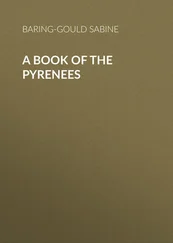Sabine Baring-Gould - The Lives of the Saints, Volume II (of 16) - February
Здесь есть возможность читать онлайн «Sabine Baring-Gould - The Lives of the Saints, Volume II (of 16) - February» — ознакомительный отрывок электронной книги совершенно бесплатно, а после прочтения отрывка купить полную версию. В некоторых случаях можно слушать аудио, скачать через торрент в формате fb2 и присутствует краткое содержание. Жанр: foreign_antique, foreign_prose, на английском языке. Описание произведения, (предисловие) а так же отзывы посетителей доступны на портале библиотеки ЛибКат.
- Название:The Lives of the Saints, Volume II (of 16): February
- Автор:
- Жанр:
- Год:неизвестен
- ISBN:нет данных
- Рейтинг книги:4 / 5. Голосов: 1
-
Избранное:Добавить в избранное
- Отзывы:
-
Ваша оценка:
- 80
- 1
- 2
- 3
- 4
- 5
The Lives of the Saints, Volume II (of 16): February: краткое содержание, описание и аннотация
Предлагаем к чтению аннотацию, описание, краткое содержание или предисловие (зависит от того, что написал сам автор книги «The Lives of the Saints, Volume II (of 16): February»). Если вы не нашли необходимую информацию о книге — напишите в комментариях, мы постараемся отыскать её.
The Lives of the Saints, Volume II (of 16): February — читать онлайн ознакомительный отрывок
Ниже представлен текст книги, разбитый по страницам. Система сохранения места последней прочитанной страницы, позволяет с удобством читать онлайн бесплатно книгу «The Lives of the Saints, Volume II (of 16): February», без необходимости каждый раз заново искать на чём Вы остановились. Поставьте закладку, и сможете в любой момент перейти на страницу, на которой закончили чтение.
Интервал:
Закладка:
On the 15th October, 1784, Mgr. Antoine-Joseph des Laurents, last bishop of S. Malo but one, examined the relics of the blessed one. He found the bones of S. John enveloped in his pontifical vestments, his pastoral staff at his side, and ring on his finger. During the Revolution the relics of the Saint were ordered to be cast into the sea, but the order was countermanded, and the sexton was required to bury them on the common fosse in the cemetery. The grave-digger, whose name was Jean Coquelin, being a good Catholic, disobeyed the order so far as to lay the bones apart in a portion of the new cemetery as yet occupied by no other bodies. In November, 1799, he announced the secret to M. Manet, a priest who had remained through the Reign of Terror, in S. Malo; and this venerable ecclesiastic assisted by another priest and some religious, verified the relics. A sealed box received the precious deposit, and it was restored to its ancient shrine on 7th March, 1823. Unfortunately the loss of a document which supplied one necessary link in the chain of evidence authenticating the relics was missing, consequently they could not be exposed to the veneration of the faithful. By a strange accident this document was recovered later; whereupon the bishop wrote to Rome to state the proofs which were now complete. The necessary sanction having been received, the sacred relics were enshrined on the 16th November, 1839, with great ceremony; and are now preserved in the Church of S. Malo.
In French, S. John is called S. Jean de la Grille; in Latin, S. Joannes de Craticula.
[Cistercian Breviary. Authority: – Radez, Chronic de las ordines y Cavall. de Santiago, Calatrava, y Alcantara.]
In the year a. d. 714, the Moors, having conquered King Roderick, took possession of Andalusia, and fortified the city of Oreto, to which they gave the name of Calatrava; of which they remained masters for nearly four hundred years, till Alfonso the Warlike took possession of it, in the year 1147, and gave it to the Templars, to guard against the irruption of the infidels. But they held it for only eight years. The forces which the Moors assembled to recover Calatrava so discouraged them, that they gave up the city into the hands of Don Sancho, who had succeeded to the kingdom of Castille, on the death of Alfonso, and withdrew from it. This prince announced to his court that if any nobleman would undertake the defence of the place, he should have and hold it, in perpetuity, as his own property. But no one offered; the host of the Moors which had so alarmed the Templars, caused equal dismay in the minds of the nobles at court. A monk of the order of Citeaux alone had courage to undertake the defence of the town. This was Don Didacus Velasquez, monk of the abbey of Our Lady of Fitero, in the kingdom of Navarre. He had borne arms before he assumed the white habit of Citeaux, and was well known to King Sancho, and this perhaps was the reason why his abbot, Don Raymond, had taken him with him on a visit to the king, about some matter concerning his monastery, at this very time. He entreated the abbot to allow him to ask permission of Sancho to undertake the defence of Calatrava. Raymond, at first, rejected the proposal, but at length, gained by the zeal and confidence of Didacus, he boldly asked the city of the prince. He was regarded as mad, but Sancho was prevailed upon by the evident assurance of the two monks to give the town of Calatrava to the Cistercian Order, and especially to the abbey of Fitero, on condition that the monks held it against the infidels. This was in 1158.
The abbot Raymond and his companion Velasquez then proposed to the king to found a military Order of Calatrava, and after having obtained his consent, they communicated their design to the bishop of Toledo, who not only approved it, but gave them a large sum of money for the fortification of the town, and accorded indulgences to all such as should take arms in its defence, or contribute arms or money for the purpose. Several persons joined the two monks, and in a short while an army was raised, at the head of which they entered Calatrava, and took possession of it. The walls were repaired and completed with such expedition and strength, that the Moors abandoned their purpose of attacking it, and withdrew.
The abbot Raymond, having nothing further to fear from the infidels, applied himself to organise the new military Order, which took its name from this town. The general chapter of Citeaux prescribed the manner of life and habit of these warrior monks, but historians are not agreed as to the colour or shape of the original habit.
As the territory of Calatrava was almost devoid of inhabitants, the abbot Raymond returned to Fitero, where he left only the aged and infirm monks, bringing all who were active and young to Calatrava, together with a great number of cattle, and twenty thousand peasants, that he might settle them in the newly acquired territory. He governed the order six years, and died at Cirvelos, in the year 1163. After his death, the knights of Calatrava, although they were novices of Citeaux into whose hands he had put arms, refused to be governed by an abbot, and to have monks among them. They elected as their Grand Master one of their number, Don Garcias; and the monks, who had chosen their new abbot, Don Rudolf, retired with him to Cirvelos, where they began an action against the knights, to eject them, that they might recover possession of Calatrava, which the king had given to their order, and especially to their house of Fitero. But a reconciliation was effected, probably through fear of the Moors, and the knights ceded to them a house at S. Petro de Gurniel, in the diocese of Osma, with all its dependencies, and there they built a monastery, leaving Calatrava in the hands of the knights.
In the year 1540, the knights were allowed to marry, and took only the vows of poverty, obedience, and conjugal fidelity; since the year 1652, they have added a fourth; to defend and maintain the Immaculate Conception of the blessed Virgin.
[Roman and Benedictine Martyrology, those of Menardus, Ferrarius, &c. Authority: – An old contemporary life, falsely attributed to Atto, B. of Pistoria.]
Verdiana was the child of poor, though well-born parents; and her knowledge of the sufferings of the poor from her own experience in early years made her ever full of pity for those in need. At twelve years old she was noted for her beautiful and modest countenance, and humble deportment. A wealthy relation, a count, took her into his house, and made her wait upon his wife. Her strict probity and scrupulous discharge of her duties so gained the confidence of her master and mistress, that they entrusted to her the entire management of their house. One day that there was a famine raging in the diocese of Florence, and the poor were in extreme distress, the girl saw some miserable wretches dying from exhaustion at the door. Her master had a vessel of beans, and she hastily emptied the box, and fed the starving wretches with them. This would have been an act of questionable morality, were it not for the extremity of the case, when, to save life, an act is justified which would have been unjust were there no such an imperious necessity. Her master had, in the meantime, sold the beans, and he shortly after returned with the money. He went to the vessel, to send it to the purchaser, but found it empty. "Then," says the contemporary writer, "he began to shout and storm against the servants, and make such a to-do as to cause great scandal in the house and among the neighbours. Now when all the house was turned topsy-turvy about these beans, and was in an uproar, the lord's hand-maiden, with great confidence, betook herself to prayer, and spent the night in supplication. And on the morrow, the vessel was found full of beans as before. Then the master was called, and she bade him abstain for the future from such violence, for Christ who had received the beans had returned them."
Читать дальшеИнтервал:
Закладка:
Похожие книги на «The Lives of the Saints, Volume II (of 16): February»
Представляем Вашему вниманию похожие книги на «The Lives of the Saints, Volume II (of 16): February» списком для выбора. Мы отобрали схожую по названию и смыслу литературу в надежде предоставить читателям больше вариантов отыскать новые, интересные, ещё непрочитанные произведения.
Обсуждение, отзывы о книге «The Lives of the Saints, Volume II (of 16): February» и просто собственные мнения читателей. Оставьте ваши комментарии, напишите, что Вы думаете о произведении, его смысле или главных героях. Укажите что конкретно понравилось, а что нет, и почему Вы так считаете.












